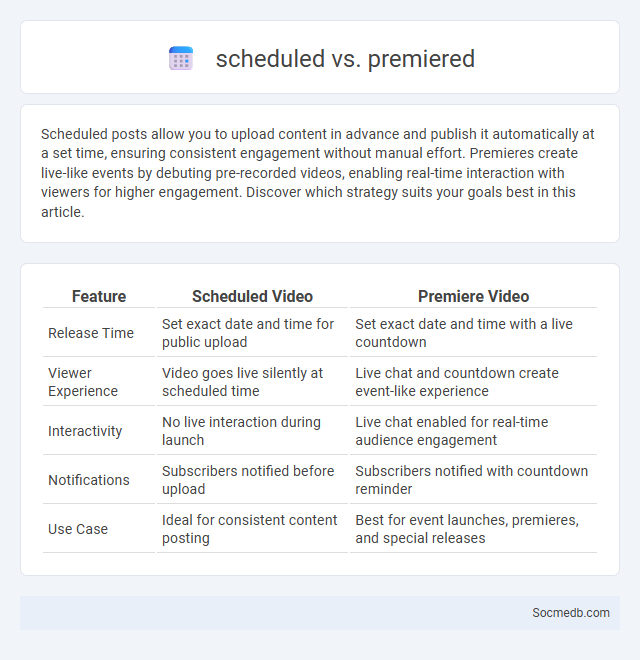
Photo illustration: scheduled vs premiere
Scheduled posts allow you to upload content in advance and publish it automatically at a set time, ensuring consistent engagement without manual effort. Premieres create live-like events by debuting pre-recorded videos, enabling real-time interaction with viewers for higher engagement. Discover which strategy suits your goals best in this article.
Table of Comparison
| Feature | Scheduled Video | Premiere Video |
|---|---|---|
| Release Time | Set exact date and time for public upload | Set exact date and time with a live countdown |
| Viewer Experience | Video goes live silently at scheduled time | Live chat and countdown create event-like experience |
| Interactivity | No live interaction during launch | Live chat enabled for real-time audience engagement |
| Notifications | Subscribers notified before upload | Subscribers notified with countdown reminder |
| Use Case | Ideal for consistent content posting | Best for event launches, premieres, and special releases |
Understanding Scheduled Content
Scheduled content on social media refers to posts created in advance and set to publish automatically at specific times, maximizing audience engagement by targeting peak activity periods. Utilizing scheduling tools such as Hootsuite, Buffer, or Sprout Social allows brands to maintain consistent posting frequency while analyzing performance metrics for continuous optimization. Effective scheduled content strategies increase reach, improve brand visibility, and foster stronger connections with followers by delivering timely and relevant messages.
What is a Premiere?
A Premiere on social media is a feature that allows users to upload a pre-recorded video and schedule it to play as a live moment, engaging viewers with real-time chat and interaction. This tool combines the benefits of pre-edited content with the excitement of a live broadcast, enhancing audience anticipation and participation. Premieres boost visibility through notification alerts, increasing reach and viewer engagement across platforms like YouTube and Facebook.
The Role of Metadata in Video Publishing
Metadata plays a crucial role in video publishing on social media by enhancing discoverability and audience targeting. Tags, descriptions, and timestamps embedded within video files enable platforms like YouTube and Facebook to index content accurately, boosting search engine optimization (SEO) and user engagement. Structured metadata also facilitates content monetization and copyright enforcement, ensuring creators maximize their reach and revenue.
Scheduled vs Premiere: Key Differences
Scheduled social media posts allow you to plan and automatically publish content at specific times, ensuring consistent engagement without manual intervention. Premieres enable you to upload pre-recorded videos that play live at a scheduled time, creating real-time interaction with your audience through comments and reactions. Understanding these differences helps tailor your content strategy to maximize audience reach and engagement on platforms like YouTube and Facebook.
Benefits of Scheduling Your Content
Scheduling your social media content ensures consistent posting, which increases audience engagement and strengthens your brand presence. With tools like Buffer and Hootsuite, you can plan your posts in advance, allowing for better time management and strategic content delivery. You can maintain a steady flow of relevant content that keeps your followers connected and boosts overall reach.
Advantages of Premieres for Audience Engagement
Premieres on social media platforms create real-time shared experiences, boosting audience engagement through live chat interactions and immediate feedback. This feature increases anticipation and excitement, encouraging viewers to participate actively during the debut of new content. Enhanced visibility from algorithm prioritization further amplifies reach and community-building opportunities.
How Metadata Impacts Content Visibility
Metadata significantly influences social media content visibility by providing search engines and algorithms with crucial information about posts, such as keywords, hashtags, and timestamps. Enhanced metadata enables better categorization and indexing, increasing the likelihood of content appearing in relevant user feeds and search results. Optimizing metadata, including descriptive titles and alt-text for images, directly boosts engagement and organic reach across platforms.
Choosing Between Scheduled and Premiere
Choosing between scheduled posts and premieres on social media depends on your content strategy and audience engagement goals. Scheduled posts allow you to maintain consistent activity by pre-planning content, while premieres create a live-event atmosphere that boosts real-time interaction and excitement. Understanding your audience's behavior helps you decide if Your content benefits more from predictable timing or the dynamic engagement of live premieres.
Best Practices for Metadata Optimization
Optimizing metadata is crucial for enhancing social media visibility and engagement through accurate and descriptive titles, tags, and descriptions. Utilizing platform-specific metadata standards, such as Open Graph for Facebook and Twitter Cards for Twitter, ensures content is displayed effectively across different networks. Incorporating relevant keywords and consistent branding within metadata improves searchability and audience targeting for social media campaigns.
Integrating Scheduling, Premieres, and Metadata for Success
Integrating scheduling, premieres, and metadata empowers your social media strategy by optimizing post timing and enhancing content discoverability. Scheduling tools allow you to reach your audience when they're most active, while premieres create anticipation and increase engagement through live content launches. Rich metadata such as tags, descriptions, and keywords improve searchability and help your content perform better across platforms, ensuring your social media success.
 socmedb.com
socmedb.com